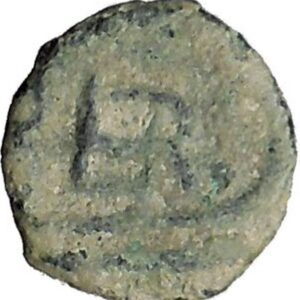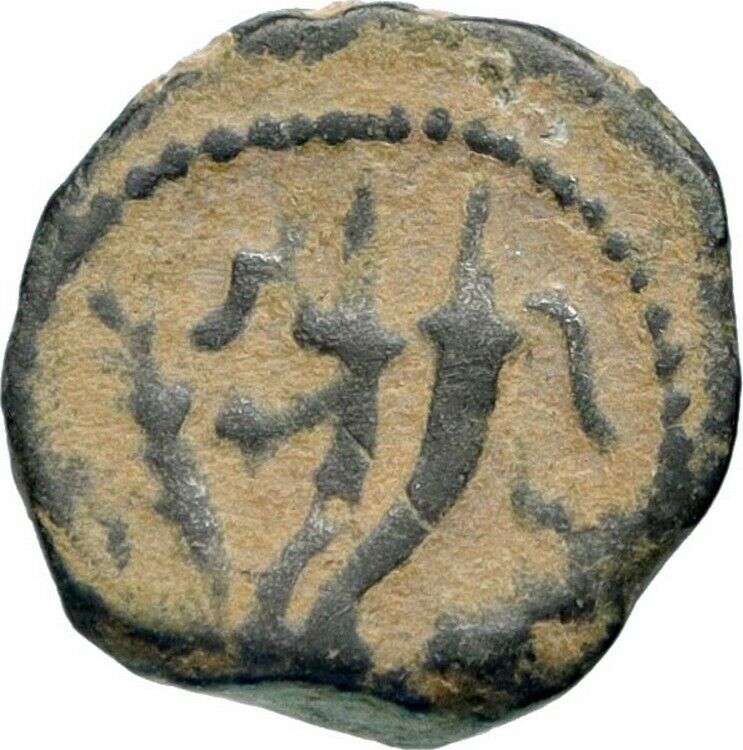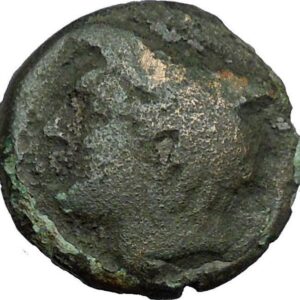|
Greek city of
Krannon
in
Thessaly
Bronze 20mm (5.07 grams) Struck 300-200 B.C.
Reference: Sear 2075; B.M.C. 7.7
Laureate head of
Poseidon
right.
KPA – Horseman galloping left.
Situated near the source of the river Onchestos, the citizens
of Krannon held Poseidon
in especially high regard.
You are bidding on the exact item pictured,
provided with a Certificate of Authenticity and Lifetime Guarantee of
Authenticity.
Poseidon or Posidon (Greek:
Ποσειδῶν
, gen:
Ποσειδῶνος) is one of the twelve
Olympian deities
of the
pantheon
in
Greek mythology
. His main domain is the
ocean
, and he is called the “God of the Sea”.
Additionally, he is referred to as “Earth-Shaker” due to his role in causing
earthquakes
, and has been called the “tamer of
horses”. He is usually depicted as an older male with curly hair and beard.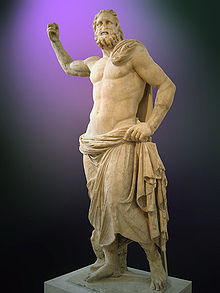
The name of the sea-god
Nethuns
in
Etruscan
was adopted in Latin for
Neptune
in
Roman mythology
; both were sea gods analogous
to Poseidon. Linear B
tablets show that Poseidon was
venerated at Pylos
and
Thebes
in pre-Olympian
Bronze Age Greece
as a chief deity, but he was
integrated into the
Olympian gods
as the brother of
Zeus and Hades
. According to some folklore, he was saved
by his mother Rhea, who concealed him among a flock of lambs and pretended to
have given birth to a colt, which was devoured by Cronos.
There is a
Homeric hymn
to Poseidon, who was the protector
of many Hellenic cities, although he lost the contest for
Athens
to
Athena
. According to the references from
Plato
in his dialogue Timaeus and Critias,
the island of Atlantis
was the chosen domain of Poseidon.
Etymology
The earliest attested occurrence of the name, written in
Linear B
, is Po-se-da-o or Po-se-da-wo-ne,
which correspond to Poseidaōn and Poseidawonos in
Mycenean Greek
; in
Homeric Greek
it appears as
Ποσειδάων (Poseidaōn); in
Aeolic
as
Ποτειδάων (Poteidaōn); and in
Doric
as
Ποτειδάν (Poteidan), (Poteidaōn), and (Poteidas). A
common epithet of Poseidon is Γαιήοχος
Gaiēochos, “Earth-shaker,” an epithet which is also identified in Linear B
tablets.
The origins of the name “Poseidon” are unclear. One theory breaks it down
into an element meaning “husband” or “lord” (Greek
πόσις (posis), from
PIE
*pótis) and another element meaning
“earth” (δᾶ (da), Doric for
γῆ (gē)), producing something like
lord or spouse of Da, i.e. of the earth; this would link him with
Demeter
, “Earth-mother.”[10]
Walter Burkert
finds that “the second element
da- remains hopelessly ambiguous” and finds a “husband of Earth” reading
“quite impossible to prove.”
Another theory interprets the second element as related to the word *δᾶϝον
dâwon, “water”; this would make *Posei-dawōn into the master of
waters. There is also the possibility that the word has Pre-Greek origin.[12]
Plato
in his dialogue
Cratylus
gives two alternative etymologies:
either the sea restrained Poseidon when walking as a foot-bond
(ποσί-δεσμον), or he knew many things (πολλά εἰδότος or πολλά εἰδῶν).
Bronze Age Greece

Poseidon, Paella Museum
If surviving Linear B
clay tablets
can be trusted, the name
po-se-da-wo-ne (“Poseidon”) occurs with greater frequency than does
di-u-ja (“Zeus”). A feminine variant, po-se-de-ia, is also found,
indicating a lost consort goddess, in effect a precursor of
Amphitrite
. Tablets from
Pylos
record sacrificial goods destined for
“the Two Queens and Poseidon” and to “the Two Queens and the King”. The most
obvious identification for the “Two Queens” is with
Demeter
and
Persephone
, or their precursors, goddesses who
were not associated with Poseidon in later periods. The illuminating exception
is the archaic and localised myth of
the stallion Poseidon and mare Demeter
at
Phigalia
in isolated and conservative Arcadia,
noted by Pausanias (2nd century AD) as having fallen into desuetude; the
violated Demeter was Demeter Erinys. In Mycenaean
Knossos
, Poseidon is already identified as
“Earth-Shaker” (e-ne-si-da-o-ne), a powerful attribute (earthquakes had
accompanied the collapse of the
Minoan palace-culture
). In the heavily
sea-dependent Mycenaean culture, no connection between Poseidon and the sea has
yet surfaced.[citation
needed]
Homer
and
Hesiod
suggest that Poseidon became lord of the
sea following the defeat of his father
Kronos
, when the world was divided by lot among
his three sons; Zeus was given the sky, Hades the underworld, and Poseidon the
sea, with the Earth and Mount Olympus belonging to all three.
Demeter and Poseidon’s names are linked in one Pylos tablet, where they
appear as po-se-da-wo-ne and da-ma-te, in the context of
sacralized lot-casting.[citation
needed]
Given Poseidon’s connection with horses as well as the sea, and the
landlocked situation of the likely Indo-European homeland, Nobuo Komita has
proposed that Poseidon was originally an aristocratic Indo-European horse-god
who was then assimilated to Near Eastern aquatic deities when the basis of the
Greek livelihood shifted from the land to the sea, or a god of fresh waters who
was assigned a secondary role as god of the sea, where he overwhelmed the
original Aegean sea deities such as
Proteus
and
Nereus
. Conversely, Walter Burkert suggests
that the Hellene cult worship of Poseidon as a horse god may be connected to the
introduction of the horse and war-chariot from Anatolia to Greece around 1600
BC.
In any case, the early importance of Poseidon can still be glimpsed in
Homer
‘s
Odyssey
, where Poseidon rather than
Zeus is the major mover of events.
Poseidon in mythology

Andrea Doria as Neptune, by
Angelo Bronzino
.
Birth
Poseidon was a son of
Cronus
and
Rhea
. In most accounts he is swallowed by
Cronus at birth but later
saved
, with his other brothers and sisters, by
Zeus. However in some versions of the story, he, like his brother
Zeus, did not share the fate of his other brother and sisters who were eaten by
Cronus. He was saved by his mother Rhea, who concealed him among a flock of
lambs and pretended to have given birth to a colt, which she gave to Cronus to
devour.
According to
John Tzetzes
the
kourotrophos
, or nurse of Poseidon was
Arne
, who denied knowing where he was, when
Cronus came searching; according to
Diodorus Siculus
Poseidon was raised by the
Telchines
on
Rhodes
, just as Zeus was raised by the
Korybantes
on
Crete
.
According to a single reference in the
Iliad
, when the world was divided by lot in
three, Zeus received the sky,
Hades
the
underworld
and Poseidon the sea. In the
Odyssey
(v.398), Poseidon has a home in
Aegae
.
The foundation of
Athens
Athena became the patron goddess of the city of
Athens
after a competition with Poseidon. Yet
Poseidon remained a numinous presence on the
Acropolis
in the form of his surrogate,
Erechtheus
. At the dissolution festival at the
end of the year in the Athenian calendar, the
Skira
, the priests of Athena and the priest of
Poseidon would process
under canopies
to
Eleusis
. They agreed that each would give the
Athenians one gift and the Athenians would choose whichever gift they preferred.
Poseidon struck the ground with his trident and a spring sprang up; the water
was salty and not very useful, whereas Athena offered them an olive tree.
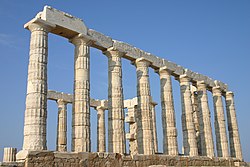
Temple of Poseidon
at
Cape Sounion
, ca 440 BC
The Athenians or their king,
Cecrops
, accepted the olive tree and along with
it Athena as their patron, for the olive tree brought
wood,
oil
and food. After the fight, infuriated at
his loss, Poseidon sent a monstrous flood to the Attic Plain, to punish the
Athenians for not choosing him. The depression made by Poseidon’s trident and
filled with salt water was surrounded by the northern hall of the
Erechtheum
, remaining open to the air. “In
cult
, Poseidon was identified with Erechtheus,”
Walter Burkert
noted; “the myth turns this into
a temporal-causal sequence: in his anger at losing, Poseidon led his son
Eumolpus
against Athens and killed Erectheus.”
The contest of Athena and Poseidon was the subject of the reliefs on the
western pediment of the
Parthenon
, the first sight that greeted the
arriving visitor.
This myth is construed by
Robert Graves
and others as reflecting a clash
between the inhabitants during Mycenaean times and newer immigrants. It is
interesting to note that Athens at its height was a significant sea power, at
one point defeating the Persian
fleet at
Salamis Island
in a sea battle.
The walls of Troy
Poseidon and Apollo, having offended Zeus by their rebellion in Hera’s
scheme, were temporarily stripped of their divine authority and sent to serve
King Laomedon
of Troy. He had them build huge walls
around the city and promised to reward them well, a promise he then refused to
fulfill. In vengeance, before the
Trojan War
, Poseidon sent a sea monster to
attack Troy. The monster was later killed by
Heracles
.
Consorts and children

Poseidon on an Attic
kalyx krater
(detail), first half
of the 5th century BC.
Poseidon was said to have had many lovers of both sexes (see expandable list
below). His consort was
Amphitrite
, a
nymph
and ancient sea-goddess, daughter of
Nereus
and
Doris
.
Poseidon was the father of many heroes. He is thought to have fathered the
famed Theseus
.
A mortal woman named Tyro
was married to
Cretheus
(with whom she had one son,
Aeson
) but loved
Enipeus
, a
river god
. She pursued Enipeus, who refused her
advances. One day, Poseidon, filled with lust for Tyro, disguised himself as
Enipeus, and from their union were born the heroes
Pelias
and
Neleus
, twin boys. Poseidon also had an affair
with Alope
, his granddaughter through
Cercyon
, his son and King of
Eleusis
, begetting the
Attic
hero
Hippothoon
. Cercyon had his daughter buried
alive but Poseidon turned her into the spring, Alope, near Eleusis.
Poseidon rescued
Amymone
from a lecherous
satyr
and then fathered a child,
Nauplius
, by her.
After having raped
Caeneus
, Poseidon fulfilled her request and
changed her into a male warrior
.
A mortal woman named
Cleito
once lived on an isolated island;
Poseidon fell in love with the
human
mortal and created a dwelling
sanctuary
at the top of a hill near the middle
of the island
and surrounded the dwelling with rings
of water and land to protect her. She gave birth to five sets of twin boys(the
firstborn who being named
Atlas
) became the first rulers of
Atlantis
.
Not all of Poseidon’s children were human. In an archaic myth, Poseidon once
pursued Demeter
. She spurned his advances, turning
herself into a
mare
so that she could hide in a herd of
horses; he saw through the deception and became a
stallion
and
captured her. Their child was a
horse
,
Arion
, which was capable of human speech.
Poseidon also had sexual intercourse with
Medusa
on the floor of a temple to
Athena
.
Medusa was then changed into a
monster
by
Athena
. When she was later beheaded by the hero
Perseus
,
Chrysaor
and
Pegasus
emerged from her neck. There is also
Triton
(the
merman
),
Polyphemus
(the
cyclops
) and, finally,
Alebion
and
Bergion
and
Otos and Ephialtae
(the
giants
).
Male lovers of
Poseidon
Worship of Poseidon

Poseidon holding a
trident
. Corinthian plaque, 550-525
BC. From Penteskouphia.
Poseidon was a major civic god of several cities: in
Athens
, he was second only to
Athena
in importance, while in
Corinth
and many cities of
Magna Graecia
he was the chief god of the
polis
.
In his benign aspect, Poseidon was seen as creating new
islands
and offering calm seas. When offended
or ignored, he supposedly struck the ground with his
trident
and caused
chaotic
springs,
earthquakes
, drownings and
shipwrecks. Sailors prayed to Poseidon for a safe voyage, sometimes
drowning horses as a sacrifice; in this way, according to a fragmentary
papyrus
,
Alexander the Great
paused at the Syrian
seashore before the climactic
battle of Issus
, and resorted to prayers,
“invoking Poseidon the sea-god, for whom he ordered a
four-horse chariot
to be cast into the waves.”
According to
Pausanias
, Poseidon was one of the caretakers
of the
oracle at Delphi
before Olympian
Apollo
took it over. Apollo and Poseidon worked
closely in many realms: in colonization, for example, Delphic Apollo provided
the authorization to go out and settle, while Poseidon watched over the
colonists on their way, and provided the
lustral water
for the foundation-sacrifice.
Xenophon
‘s
Anabasis
describes a group of
Spartan
soldiers in 400–399 BC singing to
Poseidon a paean
—a kind of hymn normally sung for Apollo.
Like Dionysus
, who inflamed the
maenads
, Poseidon also caused certain forms of
mental disturbance. A
Hippocratic
text of ca 400 BC, On the Sacred
Disease says that he was blamed for certain types of epilepsy.
Epithets
Poseidon was known in various guises, denoted by epithets. In the town of
Aegae
in
Euboea
, he was known as Poseidon Aegaeus
and had a magnificent temple upon a hill.Poseidon also had a close association
with horses, known under the epithet Poseidon Hippios. He is more often
regarded as the tamer of horses, but in some myths he is their father, either by
spilling his seed upon a rock or by mating with a creature who then gave birth
to the first horse.
In the historical period, Poseidon was often referred to by the epithets
Enosichthon, Seischthon and Ennosigaios, all meaning
“earth-shaker” and referring to his role in causing earthquakes.
Poseidon in
literature and art

Jacob de Gheyn II
: Poseidon and
Amphitrite.
In Greek art
, Poseidon rides a
chariot
that was pulled by a
hippocampus
or by horses that could ride on the
sea. He was associated with
dolphins
and three-pronged
fish spears
(tridents).
He lived in a palace on the
ocean
floor, made of
coral
and
gems
.
In the Iliad
Poseidon favors the Greeks, and on
several occasion takes an active part in the battle against the Trojan forces.
However, in Book XX he rescues
Aeneas
after the Trojan prince is laid low by
Achilles
.
In the Odyssey
, Poseidon is notable for his hatred
of Odysseus
who blinded the god’s son, the
cyclops
Polyphemus
. The enmity of Poseidon prevents
Odysseus’s return home to
Ithaca
for many years. Odysseus is even told,
notwithstanding his ultimate safe return, that to placate the wrath of Poseidon
will require one more voyage on his part.
In the Aeneid
, Neptune is still resentful of the
wandering Trojans, but is not as vindictive as
Juno
, and in Book I he rescues the Trojan fleet
from the goddess’s attempts to wreck it, although his primary motivation for
doing this is his annoyance at Juno’s having intruded into his domain.
A hymn to Poseidon included among the
Homeric Hymns
is a brief invocation, a
seven-line introduction that addresses the god as both “mover of the earth and
barren sea, god of the deep who is also lord of
Helicon
and wide
Aegae
,[61]
and specificies his twofold nature as an Olympian: “a tamer of horses and a
saviour of ships.”
Poseidon appears in
Percy Jackson and the Olympians
as the father
of Percy Jackson and Tyson the
Cyclops
.
Krannonas (Modern
Greek: Κραννώνας; ancient city:
Κραννών, Crannon) is a village and a municipality in the
Larissa Prefecture
,
Greece
located
southwest of the regional capital. Its 2001 population was 104 for the village,
185 for the municipal district and 3,274 for the municipality (1.17% of the
prefectural population). The seat of the municipality is
Agioi Anargyroi
. It is connected with the road linking
Karditsa
and Larissa. It is also located north of
Farsala
and
NNE of Palamas
and Karditsa.
Geographically the municipal boundaries extend as far south as the
Fyllio Mountains
(where
Enipeas
as bordered as its highest point is 533 m, as far north as
Koilada
and
Larissa
and
along with the Larissa metropolitan area and as far east as Nikaia and as west
with the
Karditsa prefecture
. One of the panoramic views includes its nearby
mountains to the west,
Mount Olympus
to the north,
Ossa
to the northeast and
Chalkodonio
to the south.
Krannonas was a site of
the decisive battle
of the
Lamian War
between
Macedon
and
Athens
with allies.
Thessaly was home to an extensive
Neolithic
culture around
2500 BC
.
Mycenaean
settlements have also been discovered, for example at the sites of
Iolcos
,
Dimini
and
Sesklo
(near
Volos
). Later, in
ancient Greek
times, the lowlands of Thessaly became the home of baronial
families, such as the
Aleuadae
of
Larissa
or
the Scopads of Crannon. These baronial families organized a federation across
the Thessaly region, later went on to control the
Amphictyonic League
in northern Greece. The
Thessalians
were renowned for their cavalry.
In the summer of 480 BC
, the Persians invaded Thessaly. The Greek army that guarded the
Vale
of Tempe
, evacuated the road before the enemy arrived. Not much later,
Thessaly surrendered. The Thessalian family of
Aleuadae
joined the Persians. In the
Peloponnesian War
the Thessalians tended to side with Athens and usually
prevented Spartan troops from crossing through their territory with the
exception of the army of Brasidas.
Jason of Pherae
briefly transformed the country into a significant military
power, though he was assassinated before any lasting achievements were made. In
the 4th century BC
Thessaly became dependent on
Macedon
and many served as vassals. In
148 BC
the
Romans formally incorporated Thessaly into the province of
Macedonia
, though in 300 AD Thessaly was made a separate province with its
capital at Larissa
.
It was part of the Byzantine Empire and suffered many invasions. In 977 it
was occupied by the Bulgarians, who remained there until 1014. In 1204 he was
assigned to
Boniface of Montferrat
and in 1225 to
Theodore Komnenos Doukas
, despot of
Epirus
. From
1271 to 1318 he was an independent despotate that extended to
Acarnania
and Aetolia
,
run by John III Angelos Komneno. In 1309 settled there the
Almogavars
or
Catalan Company
of the East (Societas Catalanorum Magna), which in 1310,
after lifting the siege of Thessalonica, withdrew as mercenaries in the pay of
the sebastocrátor
John II, and took over the country organized in a democracy.
From there went to the
Duchy of Athens
called by the duke Walter I. In 1318, with the extinction of
the dynasty of Angelos, the Almogavars occupied Siderocastron and southern
Thessaly (1319) and formed the
duchy of Neopatria
.
Later it was occupied by the
Serbs
until 1393,
after being dominated by the
Ottomans
. In 1821 participated in the
Greek War of Independence
, but was not recognized as part of
Greece
until
1881.
|












